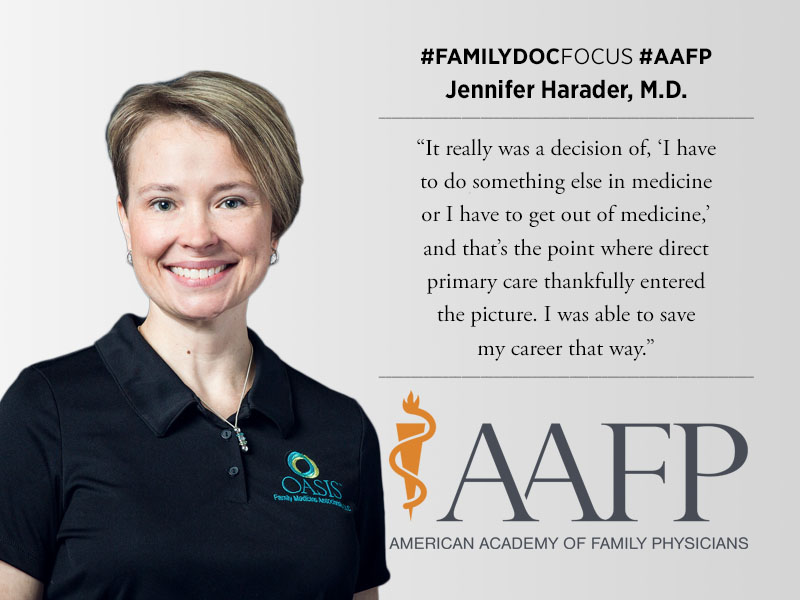Direct Primary Care Was the Change She Needed
July 6, 2021, 3:50 p.m. David Mitchell — On Christmas Eve 2014, family physician Jennifer Harader, M.D., gave herself the present she needed. She quit a job that was making her miserable.

“It really was a decision of, ‘I have to do something else in medicine or I have to get out of medicine,’ and that’s the point where direct primary care thankfully entered the picture,” she said. “I was able to save my career that way.”
After completing her training, Harader worked in a traditional fee-for-service practice in Topeka, Kan., for seven years. She said the workload and structure were not sustainable for her.
“I wanted to spend more time with my patients and make sure I met their needs when they were in the clinic,” said Harader, a founding member of the Direct Primary Care Alliance. “It became a push to address one thing and then reschedule and then address another one thing and reschedule. It became a constant complaint from my patients that they couldn’t get in to see me. I had small children at the time, and I was spending many hours charting at home. I couldn’t plan a weekend without building in time for charting.”
Harader’s neighbor and now business partner, Holly Cobb, A.P.R.N., also was working in a primary care clinic and looking for a change. The capstone project she completed while pursuing her master’s degree focused on direct primary care. She asked Harader to take the leap to DPC with her, and they opened their practice in March 2015.
Harader said about 250 of her 3,500 patients followed her to her new clinic, and she reached a full panel — roughly 600 patients in a DPC model — in about a year. Within two years, the practice needed a third clinician. Today, the practice has Harader, Cobb, three additional nurse practitioners and three nurses at two locations.
“It’s a hard job to do, so it’s easy to kind of get caught up in that sometimes,” Harader said of being a practice co-owner, “but there has never been a time where I thought we weren’t going to make it.”
Harader’s husband, Matt, an accountant by training, handles the practice’s financial administration, and the practice added an office manager this year. Harader and Cobb will give a presentation about the unique staffing needs of a direct primary care clinic July 17 during the virtual DPC Summit, and Harader also will participate in a roundtable discussion about growth strategies. Online registration for the July 16-18 event is open through July 15.
“Our nursing staff has to be well rounded,” Harader said. “We have in-house labs, so they are phlebotomists. We have an in-house dispensary, so nurses who have the credentials to do so count pills and help prepare prescriptions with our collaboration. They also do a lot of patient education. We have a lot of uninsured or under-insured patients, so the nurses have to be savvy about programs to help patients get medications that we don’t dispense in house. We try to use everyone to the top of their credentials because that’s what we need.”
That includes Harader, who now has more time for procedures than she did in a fee-for-service model, including women’s health procedures, musculoskeletal procedures, skin procedures and casting and splinting.
“For urgent needs after hours, we have patients call us first, and if we can help we meet them at the clinic,” she said. “That is a significant difference from my previous practice, where I did some occasional injections and skin procedures. I did very little acute management or fracture management because it couldn’t be built into my schedule. Choosing to do procedures at my fee-for-service practice meant choosing to run behind or choosing to give up some productivity because I had to schedule them for a long visit. And it was almost never able to be offered the same day. Now we can see the patient, talk through the risks and benefits and say, ‘Well, if you have the time, we can do that while you’re here today.’ And it’s great.”
Six years into DPC practice, Harader said her work-life balance has improved along with her work satisfaction. Instead of seeing up to 25 patients a day in 15-minute appointments, she sees an average of eight patients and each is allotted up to an hour with her, which does not include additional time the patient may need for labs or the dispensary. Fewer patients with less time constraints also means less charting at home.
“If I missed a day of evening charting in my previous practice, I’d be 10 to 12 charts behind starting the next day and looking at adding another 20 to 25,” she said. “And here, on a busy day, I’m seeing maybe 12 patients. The avalanche of work is nowhere near what it was in fee-for-service.”
Harader’s sons are now 14 and 11, and her outlook on their future career options has changed along with her own career path.
“When I was in my fee-for-service practice, I 100% would have discouraged my children from going into medicine,” she said. “Now I’m able to say, ‘You know, I really love what I do, and there is a way to be able to do it that will not eat you alive.’ So if either of my kids ended up interested in medicine, I would have no hesitation — as long as they would do DPC.”